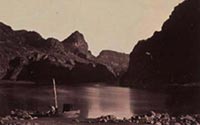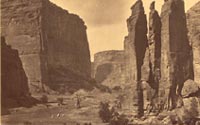Exploring the Colorado

Timothy O'Sullivan (1840-1882)
Black Cañon Looking Above from
Camp 8, Colorado River, Arizona
Albumen silver print, 1871
Prints & Photographs Division

Timothy O'Sullivan (1840-1882)
Cañon de Chelle
Walls of the Grand Cañon
about 1200 Feet in Height
1873
Prints & Photographs Division
|
In 1871 Lt. George Wheeler was put in charge of
the United States Geological Surveys West of the One Hundredth
Meridian, the fourth official exploration of the West. Wheeler
was tasked with collecting an accurate physical description of
parts of eastern Nevada and Arizona, including the topography
and mineral resources, information on resident Native Americans,
and other facts valuable for settlement and economic exploitation.
One of the first assistants he hired was the highly experienced
field photographer and surveyor Timothy O'Sullivan (1840-1882).
Probably born in Ireland, O'Sullivan joined Mathew Brady's Washington,
D.C., studio as an apprentice photographer in 1856 or 1857. It
was on the bloody battlefields of the Civil War, working first
for Brady and then Alexander Gardner, that O'Sullivan won his
reputation for technical proficiency in the tedious wet collodion
photographic process and for artistry in the field.
After having witnessed the cataclysm of his country torn by
civil war, O'Sullivan satisfied a lust for adventure by joining
government-sponsored missions intended to support America's rush
to fulfill its Manifest Destiny. O'Sullivan worked on assignments
with geologist Clarence King's survey of the Fortieth Parallel
and the Navy's Darien Survey in Panama before being chosen for
Wheeler's team.
Hoping to test the limits of practical navigation by measuring
the width and velocity of the Colorado River, Wheeler commanded
a party of three boats for the month-long journey. The trip up
the Colorado to Diamond Creek in the Grand Canyon was two hundred
miles against a strong current. Two boats in Wheeler's party--including
O'Sullivan's boat, "The Picture"--accomplished the feat of reaching
the highest point believed to have yet been navigated at the time,
with Wheeler's own boat lost in the effort.
"The Picture" is shown in this photograph with a tiny figure
aboard, who mediates between the viewer and the dramatically lit
landscape of stilled water and harsh rock walls. The photograph
provides proof that the crew survived the long and tortuous journey
through the mysterious canyon, while at the same time implying
how they must have been humbled by the chilling experience.
The Wheeler Expedition: In the 1870s, Lt. George Wheeler led
a U.S. Geological Survey of the West to collect an accurate physical
description of the territory west of the 100th meridian. O'Sullivan
and a small group traveled 35 miles across a dry, desert plateau
before descending into this fertile canyon. Their campsite is
visible in the foreground.
|

